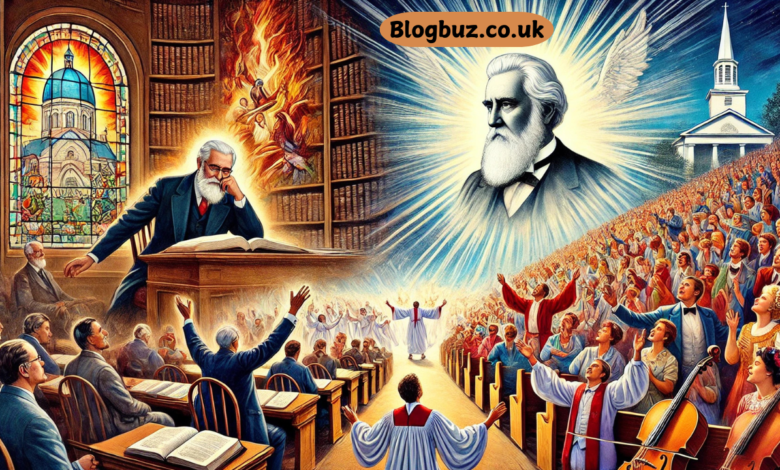BB Wafield the Asuza Street Revival Quote: Understanding Their Contrasting Views on Miraculous Gifts

The early 20th century saw a religious phenomenon that profoundly shaped modern Christianity: the Asuza Street Revival. Meanwhile, theologians like Benjamin Breckinridge (BB) Wafield addressed theological questions about miracles and spiritual gifts. These two movements—academic and experiential—present contrasting perspectives on the continuation of miraculous gifts in Christianity. This article explores the juxtaposition of BB Wafield’s theological stance and the events of the Asuza Street Revival, shedding light on their implications for contemporary faith.
Who Was BB Wafield?
Benjamin Breckinridge Wafield (1851–1921) was a prominent American theologian and the principal of Princeton Theological Seminary. Known for his rigorous scholarship and staunch Calvinist theology, Wafield was a central figure in defending biblical inerrancy and Reformed theology during the late 19th and early 20th centuries.
Wafield is particularly noted for his cessationist theology. He believed that the miraculous gifts of the Holy Spirit—such as speaking in tongues, prophecy, and healing—were specific to the apostolic age and served to authenticate the work of Christ and the apostles. According to Wafield, these gifts halted at the close of the apostolic era and the completion of the New Testament canon.
In his seminal work, Counterfeit Miracles, Wafield systematically argued against the continuation of miraculous gifts, critiquing claims of modern-day miracles as either fraudulent or psychological phenomena.
The Asuza Street Revival: A New Era of Miraculous Gifts
In stark contrast to Wafield’s cessationist views, the Asuza Street Revival (1906–1915) in Los Angeles marked the birth of the modern Pentecostal movement. Led by African American preacher William J. Seymour, the revival was characterized by extraordinary displays of spiritual gifts, including speaking in tongues, healing, and prophecy.
The revival began at a small mission on Asuza Street and quickly gained global attention. People from different racial and social backgrounds came together to experience what they believed was a fresh outpouring of the Holy Spirit. The revival emphasized the restoration of apostolic faith and practice, with miraculous gifts viewed as signs of God’s ongoing work.
BB Wafield and the Asuza Street Revival: Points of Contrast
Wafield and the Asuza Street Revival represent two vastly different approaches to understanding the role of miracles in Christianity. Let’s examine the key points of contrast:
Theological Foundations
- Wafield’s View: Wafield’s cessationism is rooted in his belief that miracles were a temporary sign to validate the apostles’ ministry. Once the New Testament was completed, he argued, the need for such signs ceased. For Wafield, the sufficiency of Scripture negates the necessity of ongoing miraculous gifts.
- Asuza Street Revival: Participants in the revival believed that the miraculous gifts of the Holy Spirit were not confined to the apostolic age. Instead, they viewed these gifts as vital to the Christian experience, demonstrating God’s power and presence in the modern world.
Miracles and Authenticity
- Wafield’s Critique: In Counterfeit Miracles, Wafield dismissed modern claims of miracles as either deceptive or misguided. He argued that many purported miracles lacked the authenticity and purpose of biblical miracles.
- The Revival’s Testimony: The Asuza Street Revival, on the other hand, claimed countless testimonies of healing, deliverance, and supernatural encounters. These experiences were evidence of God’s ongoing activity and the fulfillment of biblical promises, such as those found in Acts 2:17–21.
Emphasis on Experience vs. Doctrine
- Wafield’s Approach: Wafield emphasized theological doctrine and intellectual rigor, often critiquing emotionalism and experiential religion. His writings aimed to defend the faith against what he perceived as threats to orthodoxy.
- The Revival’s Impact: The Asuza Street Revival was deeply experiential, prioritizing personal encounters with the Holy Spirit over rigid theological formulations. This emphasis on experience attracted people from various denominations and backgrounds.
Did Wafield Address the Asuza Street Revival Directly?
There is no evidence that BB Wafield specifically addressed the Asuza Street Revival in his writings. However, his broader critique of contemporary claims to miraculous gifts would naturally extend to events like the Asuza Street Revival. Wafield’s theological framework left little room for the experiences reported during the revival.
In Counterfeit Miracles, Wafield argued that claims of modern miracles often arise from emotionalism, psychological phenomena, or fraud. While he did not name the Asuza Street Revival, his arguments provide a lens through which cessationists might critique Pentecostalism.
The Legacy of Wafield and the Asuza Street Revival
The theological and experiential divergence between Wafield and the Asuza Street Revival continues to influence Christian thought today. Let’s examine their enduring impact:
Wafield’s Legacy
- Wafield’s cessationist theology remains influential among Reformed and conservative evangelical Christians. His arguments are often cited in debates about the validity of contemporary charismatic practices.
- His defense of biblical inerrancy laid a foundation for modern evangelical theology, even beyond the scope of the miraculous gifts debate.
The Revival’s Influence
- The Asuza Street Revival gave birth to the global Pentecostal and Charismatic movements, which now comprise one of the largest and fastest-growing segments of Christianity. These movements emphasize the ongoing work of the Holy Spirit and the accessibility of miraculous gifts to all believers.
- The revival also broke racial and denominational barriers, creating a model for diverse, Spirit-filled worship communities.
Reconciling the Two Perspectives
The debate between cessationism and continuationism reflects broader questions about how Christians interpret Scripture and experience God. Here are some ways the two perspectives might be reconciled or better understood:
Acknowledging Context
- Wafield’s cessationism emerged in an era of increasing skepticism about miracles, partly influenced by the rise of modern science. His arguments sought to defend the faith against liberal theology and naturalism.
- The Asuza Street Revival arose during spiritual renewal, with participants longing for a tangible experience of God’s power.
Seeking Balance
- Some theologians suggest a middle ground, acknowledging the sufficiency of Scripture while remaining open to the possibility of miraculous gifts in specific contexts. This perspective aims to honor Wafield’s theological rigor and the experiential richness of the Asuza Street Revival.
Focusing on Unity
- Despite their differences, Wafield and the Asuza Street Revival share a common goal: glorifying God and advancing His kingdom. Christians today can learn from both perspectives, embracing theological depth and spiritual vitality.
Conclusion
The contrast between BB Wafield’s cessationism and the Asuza Street Revival’s emphasis on miraculous gifts highlights the diversity within Christianity’s theological landscape. Wafield’s scholarly critique challenges believers to test spiritual experiences against Scripture, while the revival reminds the church of the transformative power of the Holy Spirit.
As these two legacies continue to shape Christian thought and practice, they invite us to reflect on the nature of faith, the role of miracles, and how God’s Spirit works today. Whether one leans toward Wafield’s theological precision or the revival’s experiential fervor, the ultimate aim remains: to know and glorify the God of the Bible.
You May Also Read: The Enigmatic Pax Dei Iron Spike: A Symbol of Peace and Unity



